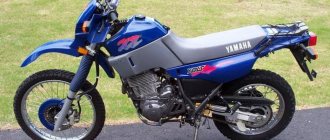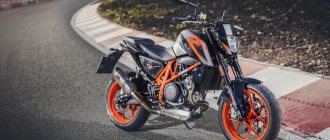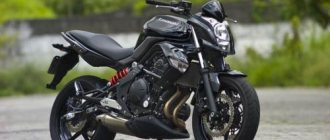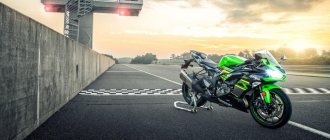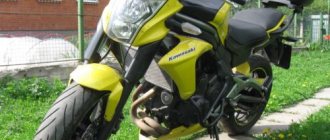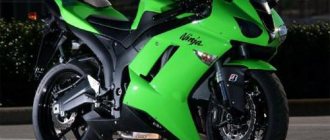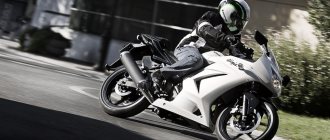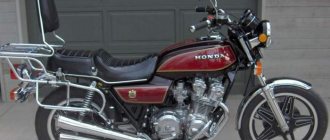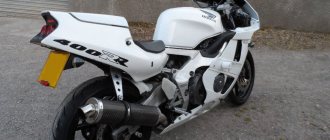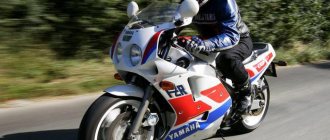Briefly about the important
Dressed in aggressive fairings, this motorcycle attracts with pleasant styling with a distinctly sporty bent.
The Kawasaki Ninja 250 is a subsequent generation of the ZZR250 motorcycle, equipped with a similar power unit that has been modernized to reduce exhaust emissions.
Side view.
Back view.
The Ninja 250 is a restyled version that replaced the old model on the assembly line in 2013 - unlike the ZZR250, the new Kawasaki is characterized by:
- New fairing and dashboard design – the improved design does not increase the aerodynamic characteristics of the motorcycle, but it has become more presentable. The plastic on the Ninja 250 is no different in concept from the more powerful 6-cell;
The instrument panel is a combination of three dial dials.
- By switching to an injector with a dual throttle body , this is an upgrade that allows you to increase the power of the motorcycle and at the same time reduce fuel consumption. The double damper has a positive effect on the internal combustion engine of the bike during an aggressive driving style, minimizing the likelihood of components overheating, which preserves the service life of the engine;
- Exhaust shape – replacing the muffler ensured a reduction in the toxicity of the motorcycle exhaust and the level of noise emitted. If desired, the stock exhaust can be freely changed to any configuration;
The first thing you notice after starting the engine is how quiet it is.
- By increasing the size of the rear cylinder - replacing the wheel has become a necessary step to increase the coefficient of adhesion to the road surface, which makes it easier to control when cornering;
- By reducing the volume of the fuel tank - from 17.8 liters, the tank was reduced to 17 in order to increase ergonomics. The new tank has a more flattened form factor, allowing for more comfortable handling of the motorcycle when reaching cruising speed.
Peculiarities
A large diameter petal brake disc paired with a 2-piston caliper allows you to feel the reliability and stability of the braking system.
- The motorcycle is equipped with transistor ignition and a liquid cooling system .
- Average fuel consumption varies within 4.6 liters per 100 km and depends on driving style.
- oil consumption is 800 g per 10,000 km .
Versions from the second model generation have anti-corrosion treatment and places for sliding sliders, which is a rare case for small-capacity motorcycles.
Positive points
Despite the modest engine size of the Ninja 250, you can’t say that this motorcycle model is somehow inferior in comparison with its more powerful brothers. Many men who only dream of a bike, who have never sat behind the wheel of such a vehicle, see just such a car in their dreams. Beginners’ poor understanding of the power of the Kawasaki 250 Ninja (the price of which, by the way, is a bit steep) and its explosive power can negatively affect their safety. After all, having developed speed on such a device, it is very easy to lose control and even crash into something. Therefore, those who want to buy a sportbike just because of the “coolness”, who want to immediately start with the “600” or “liter”, whose combat power goes off scale beyond the 100 hp mark. s, are at great risk of encountering certain troubles that plague novice motorcycle racers. This is where it will be just right to master the necessary skills on a more obedient “motorcycle friend”, which in some way forgives the shortcomings in the riding of its owner. Therefore, the presented model looks very advantageous as the first sportbike. In addition, the rather cool appearance will not leave the owner of the device without due attention. And after acquiring the required level of control of your two-wheeled friend, you can easily begin to master models with a more serious engine capacity.
But buyers who have set their own criteria when choosing a motorcycle and know what they want at the initial stage immediately begin to understand that they have settled on a bright specimen that will bring a lot of pleasure during motorcycle rides and will allow them to show off with pride in front of their friends. Don’t let the sports bike’s appearance mislead you – it won’t let you doubt its versatility. It performs just as well on short race runs as it does on long journeys.
Specifications
Main overall dimensions.
| Parameter | Characteristic |
| Frame | Diagonal steel tube design |
| Power unit | Rower 2-stroke architects for 4 cylinders |
| Valve system | DOHC, 4 valves per cylinder |
| Supply system | Fuel injection with dual throttle body or 2 CVK30 carburetors |
| Cruise power | 31.8 hp at 11000 rpm |
| Maximum torque | 22.0 Nm at 9500 rpm |
| Ground clearance | 130 mm with center stand removed |
| Cruising speed | 155 km/h or 160 km/h with carburetor |
| Acceleration to “hundreds” | 7.8 s |
| Loaded weight of the motorcycle | 169 kg or 175 kg with ABS |
Maximum speed
The most comfortable speed is about 120 km/h.
The maximum speed depends on several factors. Starting from the weight of the driver and ending with the rubber that is installed on the bike.
Our data suggests that when driving “with one driver” the maximum speed is 170 km/h.
Acceleration to hundreds
Acceleration to 100 km/h under normal conditions is 7 seconds.
Prices
- The cost of a motorcycle in new condition starts from $3,000 and depends on the configuration: the presence of an anti-lock wheel system, the type of injector or additional accessories.
- On the secondary market, the average cost in the Russian Federation is 130,000 rubles with a mileage of up to 30,000 km .
The motorcycle is equipped with separate seats.
The passenger seat is somewhat narrow in the rear.
There is a compartment for small items under the passenger seat.
Service
Maintenance of a motorcycle is inexpensive - the presence of a wide model range on the market has a beneficial effect on the cost of consumable components, in contrast to old Japanese bikes or new “sports” with larger cubic capacity.
The only major investment will be a plastic fairing - a fall on one side will cost at least 17-19,000 rubles.
What are the differences between the new Ninja 250 and the older generations?
Double headlight with bright light, allowing you to clearly see the road while driving at night.
The suspension system on the motorcycle remains the same: a telescopic fork without the possibility of user calibration at the front and a progressive mono-armor at the rear do an excellent job of the tasks.
It is comfortable to travel on a motorcycle either alone or with a passenger.
But also disc brakes with an anti-lock braking system option and a gearbox remained from the old model - these parts are interchangeable with the ZZR250 , which made it possible to increase the maintainability of the motorcycle and reduce costs in further production of the equipment.
Different versions
The model is perfect for beginner bikers.
This is interesting! Almost the entire Kawasaki Ninja 250 model range is characterized by electronic fuel injection , operating on the principle of independent fuel supply to each engine cylinder, and only the Ninja variations for North America operate on the carburetor principle. Kawasaki took this step to improve rider safety while operating the bike, since this model is often purchased by novice drivers.
The main advantage of the injection type of power supply is a smooth increase in torque, which allows you to steadily increase the speed of the motorcycle, while the carburetor version is characterized by a choppy power delivery, in particular with a poorly tuned device.
Brakes squeal
The braking system only needs minimal grinding in to work at full power after just a couple of laps. The front brake disc is presented in a single copy, which, however, does not give reason to talk about the weakness of the dynamics of the braking process. Petal-type discs are excellent at dissipating heat. Therefore, even a series of sharp speed reductions will not seriously affect the effectiveness of the brakes. Both the rear and front modules of the system are well modulated. The feeling of fear will not affect the motorcyclist when making a turn with braking - the accident of the wheel slipping into a skid is minimal. Well, without any comments: this motorcycle does not have brake and clutch release adjustment. And it wouldn’t interfere at all with such a beast as the Kawasaki 250 Ninja. However, this is not a critical problem that you just need to get used to.
Kawasaki Ninja 250 – is it strong enough for an experienced rider?
At first it may seem that there is not enough “power”, but after driving several tens of kilometers, you understand that, in principle, this is quite enough.
The new Ninja 250 produces 32 horsepower, which is more than enough for beginners or insecure drivers, but the smooth delivery of torque and medium-length gears will quickly make you outgrow this motorcycle.
The power of this motorcycle is enough for smooth, but mobile movement around the city with economical fuel consumption, and you shouldn’t expect more from it.
Note to the pilot
It is quite clear that an aggressive driving style will require not only good engine performance. Equally important is the balance of the entire chassis and stability of feedback. Regardless of the type of surface—pockmarked with small holes or asphalt sprinkled with sand—the pilot must feel both the road and the motorcycle. Otherwise, it is easy to lose control of the movement during a serious lean or sudden braking. Of course, not only the lap time will depend on this feeling - the driver’s health may also be in question! In this regard, you can rely on the Ninja 250: the standard suspension setup is quite good, and together with high-quality tires, it allows you to maintain full contact with the asphalt. This gives the driver the ability to feel the road while riding the Kawasaki Ninja 250. Reviews from owners confirm that the device's handling is quite good.
conclusions
The Kawasaki Ninja 250 is the best option as a transhipment base for civilian motorcyclists, allowing them to understand the difference between a road bike or chopper with sports motorcycles.
The motorcycle is easy to ride due to its low weight.
The small volume of the internal combustion chamber causes weak acceleration, which, together with the mass of electronics, allows you to quickly get used to the bike . In this regard, the manufacturing company at the beginning of 2021 released a globally modified version, distinguished by a power of 39 horsepower, which replaced the old generation on the market along with the Ninja 300 model.
